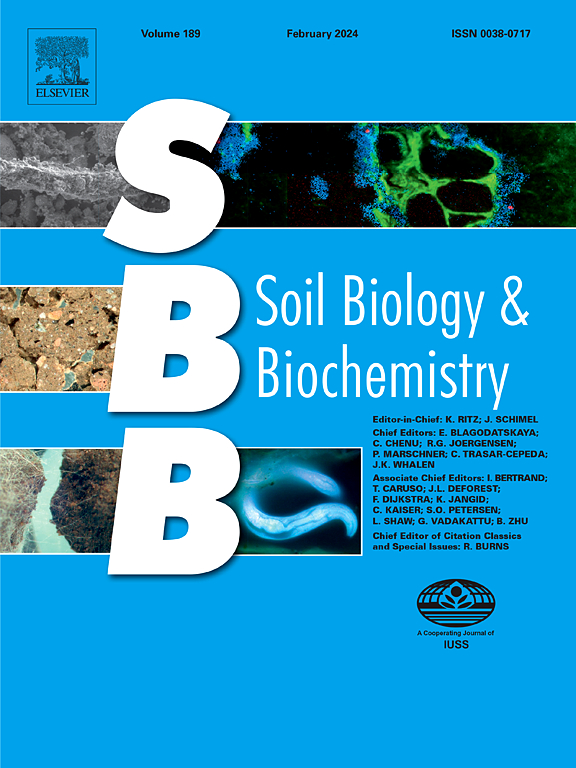解析土壤有机质能量利用通道:LC-FT-ICR-MS揭示长期施肥和坏死块的影响
IF 9.8
1区 农林科学
Q1 SOIL SCIENCE
引用次数: 0
摘要
据报道,施肥可增加土壤有机质(SOM)含量、微生物活性和微生物代谢物的丰度,这表明总体上坏死块标记物的丰度在增加。SOM的化学复杂性阻碍了我们对SOM转化、坏死团印记和能量储存之间的机制联系的理解。非靶向分子水平技术可以深入了解SOM的分子组成、能量指纹和施肥效应。采用液相色谱-傅里叶变换离子回旋共振质谱(LC-FT-ICR-MS)对长期施肥土壤中的水提有机物(WEOM)与新鲜植物、细菌和真菌坏死物提取物进行了比较。施肥增加了极性、不饱和、氧化和贫能化合物的WEOM复杂性。这些变化与坏死块标记物增加2-3倍有关。与未施肥的土壤相比,施用肥料的WEOM以细菌坏死块标记为主,而非真菌标记,表明细菌控制了WEOM能量特性的变化。虽然未施肥土壤显示出较小的坏死块印记,但真菌含氮标记存在,表明真菌的能量利用渠道更占优势,具有潜在的氮开采潜力。尽管在土壤中坏死团的印迹和NOSC发生了平行的变化,但83%的公式没有被分配给任何坏死团,但通过长期施肥解释了大部分向更具生物可利用性、氧化性和能量低下的WEOM的转变。这可能表明,施肥促进了与新坏死块无关的预先存在的SOM的氧化(“启动”)。或者,这可能表明在我们的研究中缺少对坏死块组成变异性的覆盖。我们展示了LC-FT-ICR-MS的潜力,通过报告约600个新的、易溶的微生物坏死块标记物来补充经典的坏死块标记物研究,从而为建立全面的数据库提供了一条途径,以便在未来对SOM来源和转化过程进行更强大的注释。本文章由计算机程序翻译,如有差异,请以英文原文为准。

Deciphering the Energy Use Channels in Soil Organic Matter: Impacts of Long-term Manure Addition and Necromass Revealed by LC-FT-ICR-MS
Manuring of arable soils has been reported to increase soil organic matter (SOM) contents, microbial activity, and abundance of microbial metabolites, suggesting an increasing abundance of necromass markers in general. SOM’s chemical complexity hampers our understanding of mechanistic links between SOM transformation, necromass imprints, and energy storage. Non-targeted molecular-levels techniques can provide insight into SOM’s molecular composition, energetic fingerprint and effects of manuring. We compared water-extractable organic matter (WEOM) from long-term manured soils with a set of fresh plant, bacterial and fungal necromass extracts by liquid chromatography Fourier transform ion cyclotron resonance mass spectrometry (LC-FT-ICR-MS). Manuring increased WEOM complexity in polar, unsaturated, oxidised and energy-poor compounds. These changes were linked to a 2-3-fold increase in necromass markers. In comparison to unfertilized soil, manured WEOM was dominated by bacterial necromass markers over fungal ones, suggesting bacterial control of changes in WEOM’s energetic properties. Although unfertilized soils showed a smaller necromass imprint, fungal N-containing markers were present, suggesting a more dominant fungal energy use channel, and potential N mining. Despite the parallel shifts in necromass imprints and NOSC between soils, 83% of formulas were not assigned to any necromass, but explained most of the shift to a more bioavailable, oxidized and energy-poor WEOM via long-term manuring. This could suggest that manuring promotes the oxidation of pre-existing SOM not associated to fresh necromass (“priming”). Alternatively, this could point to a missing coverage of necromass compositional variability in our study. We demonstrate the potential of LC-FT-ICR-MS to complement classical necromass marker studies by reporting ∼600 novel, readily soluble microbial necromass markers, thereby providing an avenue to build comprehensive databases for a more robust annotation of SOM sources and transformation processes in the future.
求助全文
通过发布文献求助,成功后即可免费获取论文全文。
去求助
来源期刊

Soil Biology & Biochemistry
农林科学-土壤科学
CiteScore
16.90
自引率
9.30%
发文量
312
审稿时长
49 days
期刊介绍:
Soil Biology & Biochemistry publishes original research articles of international significance focusing on biological processes in soil and their applications to soil and environmental quality. Major topics include the ecology and biochemical processes of soil organisms, their effects on the environment, and interactions with plants. The journal also welcomes state-of-the-art reviews and discussions on contemporary research in soil biology and biochemistry.
 求助内容:
求助内容: 应助结果提醒方式:
应助结果提醒方式:


